Prime Minister Scott Morrison ran the media gamut over the weekend spruiking that ‘skilled’ migration would return to pre-pandemic levels by mid-2022, and that Australia’s international border would remain open no matter what.
In an interview with the Saturday Herald-Sun, Scott Morrison told the paper that “skilled migration will be back to normal by the first half of next year to ease critical workforce shortages across the country”.
He also told 9News that the federal government’s post-COVID economic recovery plan includes the return of skilled migrants:
“We are going to have a business led recovery here in Australia,” Prime Minister Scott Morrison said…
Since Australia shut its borders, businesses and industries have been struggling with a shortage of workers.
Whereas Morrison used a speech to the Victorian Chamber of Commerce and Industry to state that skilled migration to resume “as soon as possible”.
When asked about a “Big Australia” policy would be part of the immigration reboot, Morrison deflected to the old canard of ‘migrants to the bush’:
Mr Morrison said the government needed to “get the balance right” on migration, with new arrivals funnelled into regional areas to prevent further housing affordability and congestion issues in capital cities.
Pre-COVID levels of immigration is a ‘Big Australia’ policy. As explicitly noted in the latest Treasury Intergenerational Report (IGR), Australia’s population will increase by 13.1 million (~50%) over the next 40 years on the back of mass immigration of 235,000 people a year:
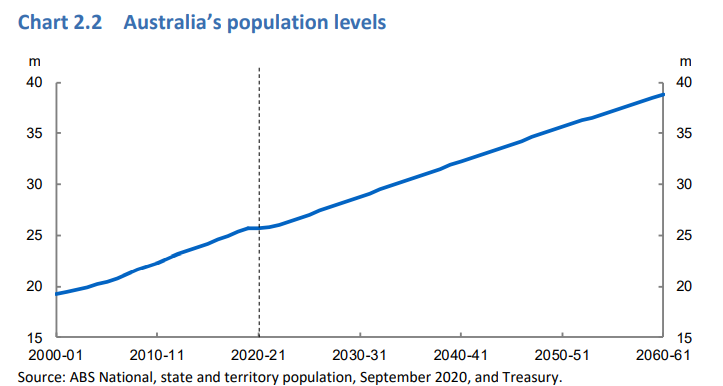
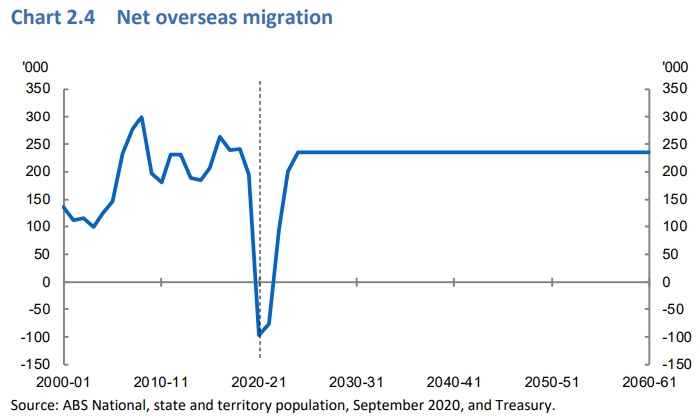
This is the equivalent to adding another Sydney, Melbourne plus Brisbane to Australia’s existing population.
Australia’s economic performance in the decade leading up to COVID was abysmal, with per capita GDP and income growth collapsing:
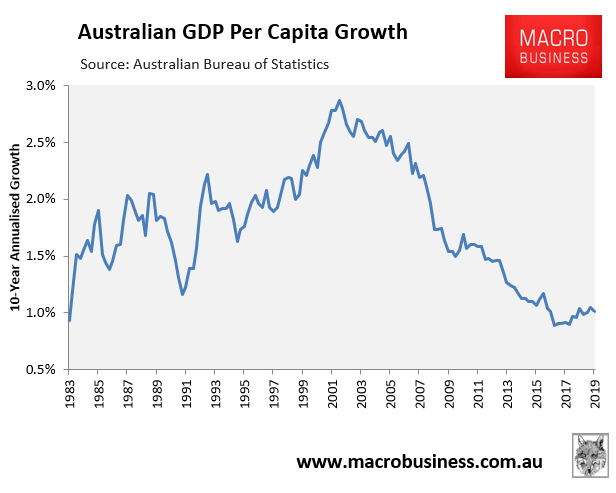
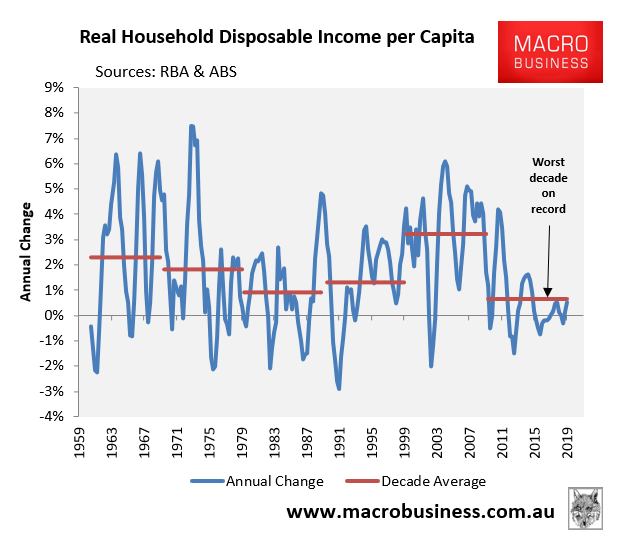
Australia’s labour productivity growth also collapsed amid the extreme pre-pandemic immigration:
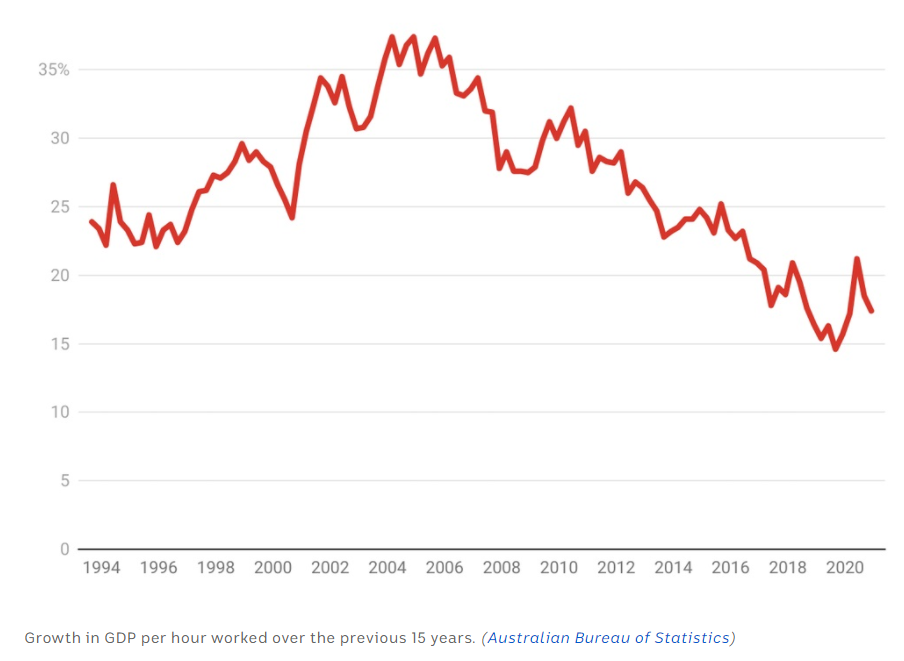
Recall that Professor Gary Banks – the long-time former chief of the Productivity Commission (PC) – has shredded the planned reboot of Australia’s mass immigration policy, warning that it will wreck the nation’s productivity and living standards:
“Immigration obviously increases the size of our population and thus our economy. But it need not raise the incomes or living standards of the existing population. And that should be the primary goal, at least in economic terms”…
“In per capita income terms, empirical studies by the Productivity Commission and others have repeatedly found that the gains from immigration are small and largely skewed to migrants themselves. And that’s without considering environmental and other negative impacts”…
[Big Australia] “ignores the capacity of our economy and society to absorb migration running at more than twice the rate Treasury itself had previously projected. More people obviously require more infrastructure and more services”…
“To the extent that migrants are more highly skilled than locals in areas where these are needed, then of course that should help our overall productivity performance”.
“But there are questions as to whether in practice migrants have been meeting that test. Indeed there is some evidence that the definition of ‘skill’ has got more elastic and permissive over time. The surge in the skilled immigration over the past decade coincided with a slump in Australia’s productivity performance, which also is not encouraging”…
“Business groups and the universities naturally want to maximise the intake so as to increase their markets and their revenues. But immigration has wider costs and benefits across the community. These need to be assessed and discussed in an open way before decisions are made”…
“There has to be a better way.”
Separately, Gary Banks recommended a level of net overseas migration (NOM) of only 90,000 annually, not the 235,000 projected by Treasury’s IGR:
Treasury’s budget forecasts envisage net immigration getting back to its previous annual peak of 235,000 by 2025… One has to question whether, federal budget repair aside, attempts to revive immigration to the extent forecast would be sensible from a national interest perspective. While Treasury is perhaps understandably bullish, the Productivity Commission has provided a more nuanced assessment. This suggests that, under realistic assumptions, immigration does little for either participation or productivity nationally in the long term, with income gains in per capita terms small and largely skewed to migrants themselves…
When externalities such as congestion and housing affordability are taken into account, I’d suggest that the optimal level of net immigration for Australia could be closer to Treasury’s forecast in the first IGR of 90 000 than the latest one.
Sadly, don’t expect much pushback from Labor. Over the weekend, leader Anthony Albanese penned an article in Herald-Sun supporting a strong skilled migration program:
The current gap for skilled workers we will need to fill through migration includes engineers, geologists, nurses and aged care workers…
Skilled migration will continue to be required to meet demand for workers in a growing economy…
Thus, the bipartisan ‘Big Australia’ mass immigration is back. And with it, Australia’s economy will again be zombified with painfully low per capita GDP and income growth, alongside poor productivity and wage growth.
Repeating the same mistakes all over again and expecting a different result is the definition of insanity.

